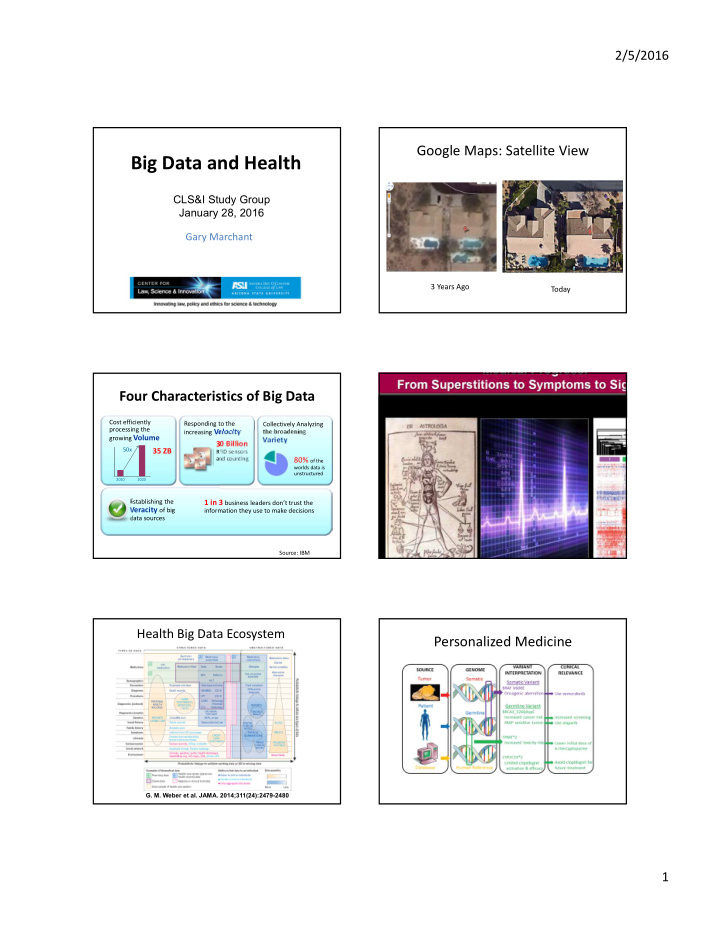



2/5/2016 Google Maps: Satellite View Big Data and Health CLS&I Study Group January 28, 2016 Gary Marchant 3 Years Ago Today Four Characteristics of Big Data Cost efficiently Responding to the Collectively Analyzing processing the increasing Velocity the broadening growing Volume Variety 30 Billion 50x 35 ZB RFID sensors and counting 80% of the worlds data is unstructured 2010 2020 Establishing the 1 in 3 business leaders don’t trust the Veracity of big information they use to make decisions data sources Source: IBM Health Big Data Ecosystem Personalized Medicine G. M. Weber et al. JAMA. 2014;311(24):2479-2480 1
2/5/2016 Source: Stephens et al., PLOS Biology (2015) Precision Medicine Initiative 2
2/5/2016 Killer Bug is Traced at NIH Hospital WSJ The analysis reveals that the outbreak in Sierra Leone was sparked by at least 8/22/12 two distinct viruses, introduced from Guinea at about the same time. It is • Genetic sequencing used to track deadly strain of unclear whether the herbalist was infected with both variants, or whether antibiotic ‐ resistant Klebsiella pneumonia strain perhaps another funeral attendee was independently infected. One Ebola virus through 18 patients at NIH hospital ( 6 of whom lineage disappears from patient died) samples taken later in the outbreak, while a third lineage appears. That • Mutation profiling permitted identification of who lineage—tied to a nurse who was traveling to reach a hospital but died passed the bug to whom, where, and how (e.g., along the way—seems to have spray from sink) originated when one of the lineages present at the funeral gained a new • “This level of certainty is going to change the concept mutation. This third lineage was spread, Garry says, via a truck driver who of hospitals’ responsibility.” transported the nurse, as well as others – 1 in 20 hospitalized patients picks up infection, kills who cared for her in the town where she died. 100,000 people per year 3
2/5/2016 https://www.youtub e.com/watch?v=4z Mms2C6YUk#t=259 4
2/5/2016 Sewage Monitoring Since its launch, FoodBorne Chicago classified more than 3,700 tweets related to food poisoning in Chicago, which led to 722 food poisoning reports submitted to CDPH through FoodBorneChicago.org. Based on these reports, 526 inspections were conducted which led to critical or serious violations being found at 112 food establishments, violations which would not have been identified as quickly without the use of data from Twitter. 5
2/5/2016 Louisville: Asthma Tracker • “More than 500 Louisville asthma sufferers are being equipped with special, high tech inhalers – ones that collect data about where and under what circumstances the inhaler is used. By GPS plotting that information along with data from other sources about air quality – neighborhood risk factors, school conditions, etc. – we hope to get new insight into what prompts an asthma attack.” Greg Fischer, Mayor Discussion Questions 1. What are the most promising applications of big data in the health care context? How will such big data applications improve health care quality and/or costs? 2. How big a problem will “false positives” be for big data in health care? Will the incidentalomas overwhelm our health care system and increase health care costs? 3. Much of the health big data will be predictive of future disease and problems rather than about an existing health problem. How much do you want to know about your risks and predispositions to future disease? 4. How will people respond to more predictive and diagnostic data about their health? Indifference? Feeling helpless? Anxiety? Take helpful actions in response to data? 5. Who should have access to health big data, and how would they obtain access? Given that the power of the data is proportional to the size of the data base, should there be a national health data base? What other policies can or should encourage sharing and access to data by researchers, providers, and policymakers? 6. What are the privacy, liability and regulatory implications of the big data era in health care? 6
Recommend
More recommend